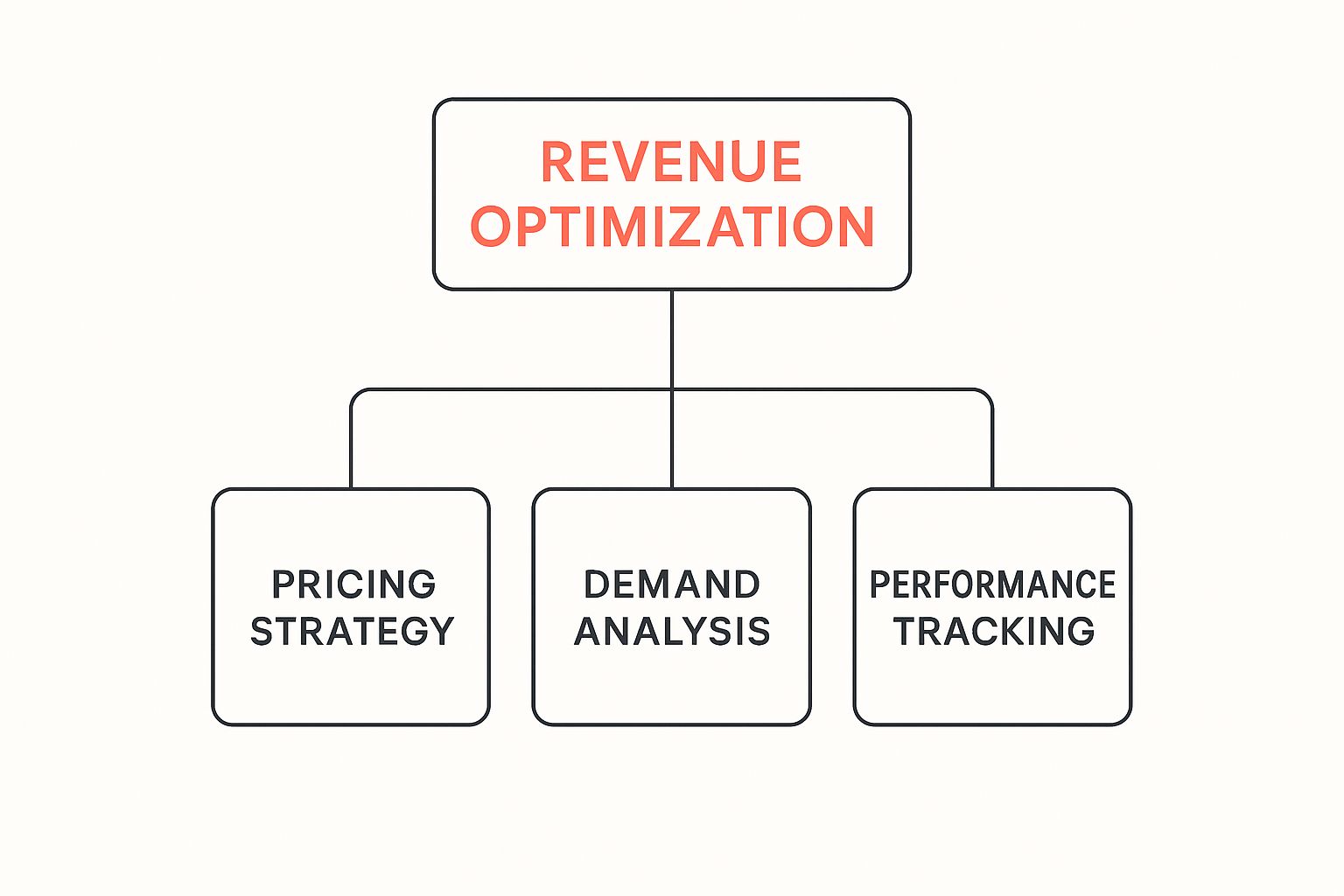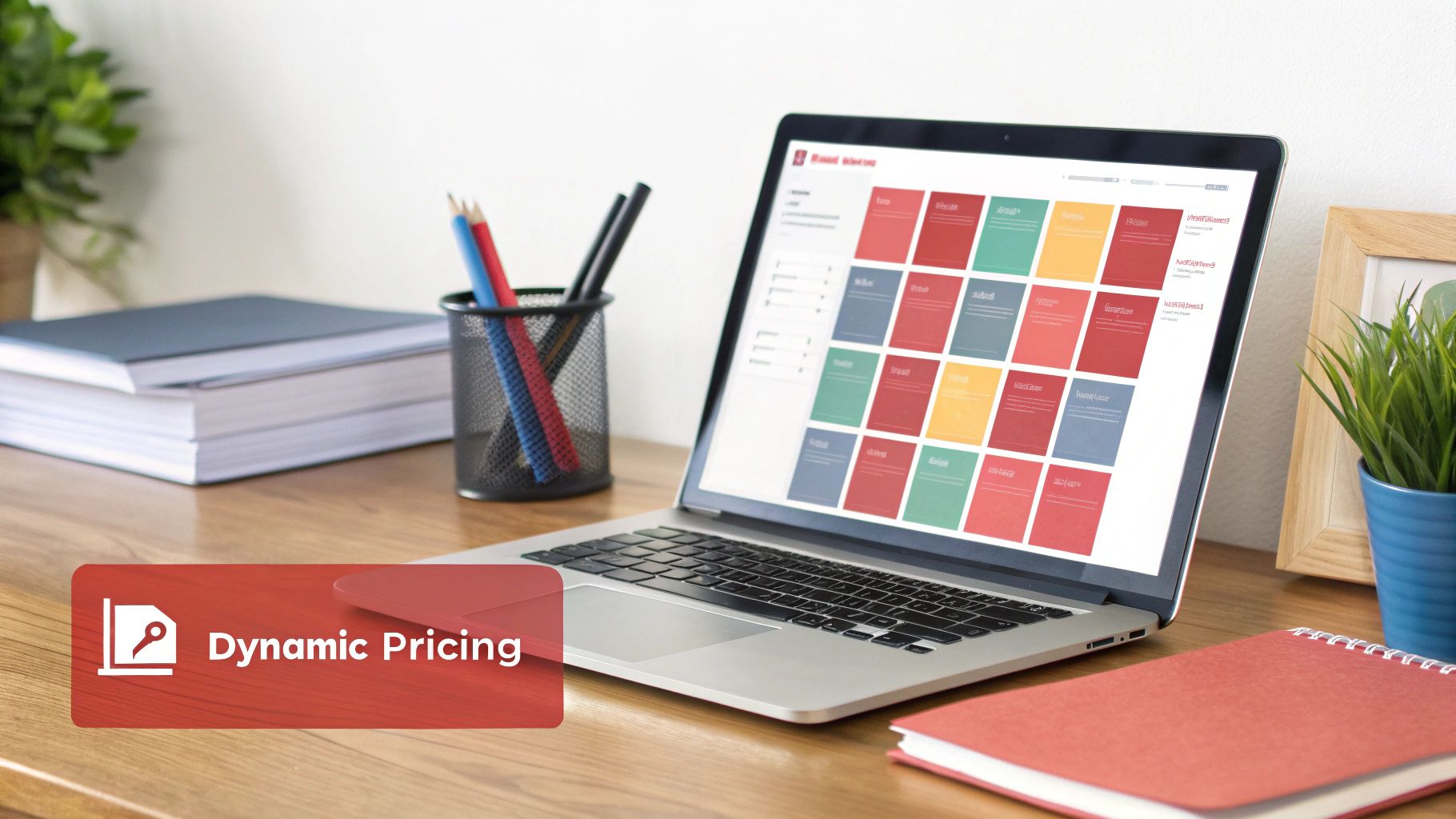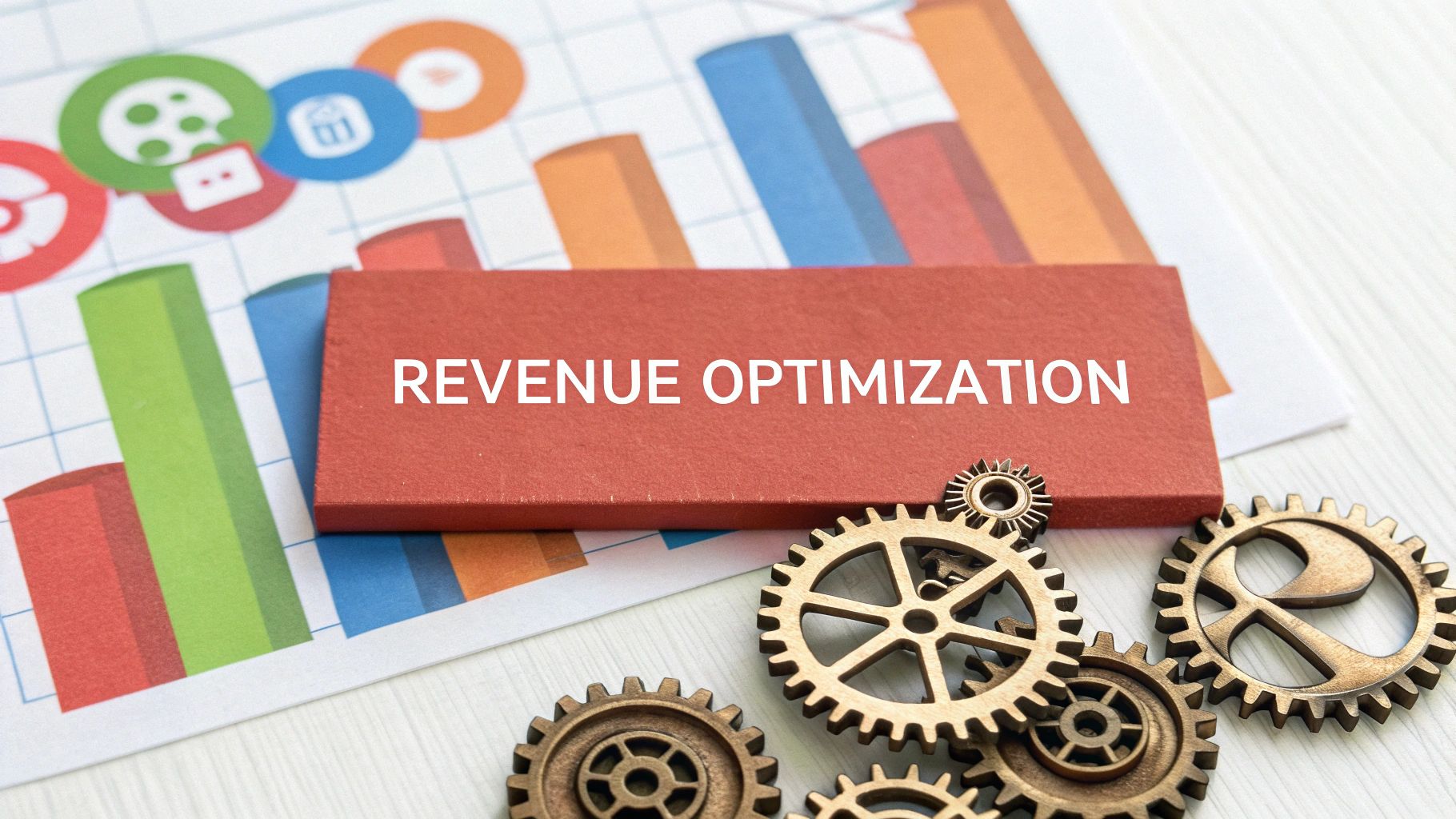For any agency, revenue optimization is a holistic strategy. It’s about squeezing every last drop of profitability out of each client engagement by smartly aligning your pricing, service delivery, and client management. This isn't just a fancy way of saying "charge more." It’s about earning more from the work you’re already doing by making better, data-backed decisions across your entire operation.
Defining Revenue Optimization for Your Agency's Bottom Line
Too many agency leaders hear "revenue optimization" and immediately think it's all about hiking up their prices. While pricing is definitely a piece of the puzzle, the real strategy for agencies goes much, much deeper.
Think of your agency as a high-performance engine. Your sales team, account managers, and project delivery crew are all critical, interconnected parts. If they aren’t firing in perfect sync, you’re leaking power—and that means leaking profit. Simple as that.
Revenue optimization is the process of getting under the hood and fine-tuning that engine. It's about systematically digging into your operations to find and plug those leaks, making sure every single part of your agency is pulling its weight and contributing to maximum profitability. It’s the art of connecting your services, pricing, and client relationships to boost both the value you deliver and the profit you keep.
To get a real handle on what revenue optimization is, you have to look at its core components. These aren't just separate tasks; they're the pillars that work together to build a stronger, more profitable agency.
Before we dive deeper, here’s a quick overview of the core components that drive a successful revenue optimization strategy within an agency.
The Four Pillars of Agency Revenue Optimization
Each pillar supports the others, creating a solid foundation for sustainable growth.
This is how all those concepts branch out from the main strategy.

As you can see, real optimization isn’t a one-and-done action. It’s a living system where pricing, client demand, and team performance are constantly being measured and adjusted. By focusing on these areas, you shift from just reacting to problems to proactively building an agency that’s built to last.
Why Your Agency Can’t Afford to Ignore Revenue Optimization

Is your agency constantly putting out fires? Things like razor-thin profit margins, unpredictable cash flow, and clients walking out the door can feel like separate, unrelated headaches. But they're not. They're all symptoms of a disconnected revenue strategy.
In today's competitive landscape, you can't afford to leave money on the table. And without a deliberate approach to revenue optimization, that's exactly what's happening.
Ignoring this is like trying to sail a ship without a rudder. Sure, you're floating, but you have almost no say in where you're going or how fast you'll get there. You end up just reacting to the currents of client demands and market shifts instead of proactively steering your agency toward calm, profitable waters.
Shifting from Reactive Firefighting to Proactive Growth
Most agencies get stuck in a reactive cycle. A big client threatens to leave, so you slash your rates to keep them. A project creeps way over budget, so you eat the cost to avoid a tough conversation. Sound familiar? Each of these small decisions slowly chips away at your profitability.
This constant firefighting has some serious consequences for your agency:
- Shrinking Profit Margins: You find yourself bending over backward for low-value clients while your most profitable accounts are unintentionally neglected.
- Unpredictable Cash Flow: When you're dependent on one-off projects and shaky retainers, trying to forecast your finances feels like a total guessing game.
- High Client Churn: If your pricing doesn't align with the value you deliver, clients will always be looking for a better deal. This means you're stuck in a costly cycle of constantly replacing them.
A real revenue optimization strategy flips this entire script. It gives you the data and the framework to stop plugging leaks and start building a more valuable, long-term business. This shift is what separates the agencies that are just scraping by from the ones that are truly thriving.
Understanding the True Cost of Inaction
The cost of doing nothing isn't just about the immediate revenue you're missing. It’s the slow, quiet erosion of your agency’s health and its future potential. When you don't know which services are most profitable or which clients are worth investing in, you're essentially flying blind.
By not optimizing revenue, agencies inadvertently train clients to undervalue their work. This creates a weak negotiating position and a business model that is perpetually vulnerable to market shifts and client budget cuts.
This is exactly why figuring out what is revenue optimization becomes so critical. It’s not about some complex financial wizardry. It’s about building a smarter, more durable agency.
It’s about gaining the clarity to price your services with confidence, the insight to double down on your best client relationships, and the systems to grow each account methodically. It’s the key to transforming your agency from just another service provider into an indispensable strategic partner.
4 Actionable Revenue Optimization Strategies for Agencies

Knowing the theory behind revenue optimization is one thing. Actually putting it into practice is what separates the agencies that thrive from those that just survive. This is where we move past the buzzwords and get into field-tested strategies that directly fatten up your bottom line.
These aren't massive, complicated overhauls. They’re practical, powerful shifts in how you price, package, and sell your services to squeeze every last drop of profitability from each client relationship.
Let’s break down four of the most effective strategies your agency can start using today.
Strategy 1: Adopt Dynamic and Value-Based Pricing
For many agencies, the traditional "billable hour" is the biggest profit leak you have. It puts a hard cap on your earning potential and pigeonholes you into selling time, not outcomes. It's time to flip that script.
Value-based pricing ties your fees directly to the value you create for the client. Think about it: for a digital marketing agency, this could be a pricing tier based on hitting lead generation milestones. For a web design firm, maybe it’s a fee structure that scales with the client’s conversion rate improvements after launch.
This simple change shifts the entire conversation. You're no longer talking about "How many hours will this take?" but "What business results can we drive together?" This aligns your success with your client's, creating a real partnership and unlocking much higher revenue potential.
Strategy 2: Curate Your Service Portfolio for Profitability
Not all of your services are created equal. Some offerings, while popular, might have razor-thin margins and suck up a huge amount of your team's time and energy. A core piece of revenue optimization is managing your service portfolio like a savvy investor manages stocks.
Start by running a profitability analysis on everything you offer. Find your high-margin, high-demand services—these are your winners. At the same time, pinpoint the low-margin, high-effort services that are secretly draining your resources.
Once you have that clarity, you can make some smart moves:
- Double Down: Go all-in on promoting your most profitable offerings. Build your sales process around them.
- Re-Package: Bundle lower-margin services with your high-value ones to lift the overall deal's profitability.
- Phase Out: Make a plan to either sunset or outsource the services that consistently fail to hit your profit targets.
Strategy 3: Segment Clients to Focus Your Best Resources
Just like your services, not all clients bring the same value. A common trap for agencies is treating every client the same, spreading their best people and resources thinly across the entire portfolio. This is a massive mistake.
Effective client segmentation means categorizing your clients based on revenue, profitability, and potential for growth. A simple A-B-C model works wonders here:
- 'A' Clients: These are your top 15-20% of clients. They generate the most profit and have the strongest partnership potential. They deserve your top talent and proactive account management.
- 'B' Clients: Your solid, middle-of-the-road clients. They're consistent but might not have huge growth potential. Serve them with efficient, standardized processes.
- 'C' Clients: The bottom tier. They're often small, demanding, and low-profit. These relationships need to be re-evaluated or moved to a lower-touch service model.
By segmenting, you can aim your most valuable resources—your time and your top talent—where they’ll make the biggest dent in your revenue.
Strategy 4: Build Systematic Upsell and Cross-Sell Pathways
The easiest sale you'll ever make is to an existing, happy client. But most agencies leave upselling and cross-selling completely to chance, just hoping a client will ask for more work. Revenue optimization demands a more structured approach.
Map out your entire client journey and identify the natural points where you can introduce more value. Just launched a killer new website for a client? That's the perfect time to pitch an SEO or content marketing retainer. Getting your team better at spotting these moments is critical for agency growth.
For a deeper look into concrete methods for growing your agency's revenue streams, check out these proven product growth strategies. A systematic approach turns one-off projects into long-term, high-value partnerships, which is how you dramatically boost client lifetime value.
Your Agency's Roadmap to Implementing Revenue Optimization
An idea is only as good as its execution. You can read all the strategies in the world, but actually turning them into a tangible plan is what will spark real change for your agency. This is where we get into the nuts and bolts—a clear, step-by-step roadmap to get you started without feeling like you need to boil the ocean.
The key here is a practical, phased approach. We're not talking about a massive, disruptive overhaul. Instead, it’s about starting small, testing your ideas with a handful of clients, and then scaling what works across your entire business. It's a methodical way to build a more profitable operation, one piece at a time.
Step 1: Start with a Comprehensive Data Audit
Before you can optimize a single thing, you have to get an honest look at what’s actually happening inside your agency. A data audit is that crucial first step. It moves you from gut feelings and assumptions to hard, factual insights.
Think of it like turning on the lights in a dark room—suddenly, you can see where the real opportunities (and problems) are hiding.
Your goal is to answer a few critical questions:
- Which services really make us money? Look past the top-line revenue. You need to factor in the time, resources, and overhead it takes to deliver each service to find your true profit engines.
- Who are our most valuable partners? This isn't just about who pays the most. Identify the clients who have high growth potential and are a genuine pleasure to work with—the ones who fit your agency's culture and expertise like a glove.
- Where are the hidden profit leaks? Get granular. Pinpoint the types of projects that consistently go over budget, the clients who demand excessive non-billable time, or the services with surprisingly thin margins.
This initial analysis becomes the foundation for your entire revenue optimization plan.
Step 2: Set Clear Goals and Define Your KPIs
With your data in hand, you can shift from analysis to action. The next step is to set specific, measurable, achievable, relevant, and time-bound (SMART) goals. Vague ambitions like "increase revenue" just won't cut it. You need concrete targets to aim for.
For instance, your agency's goals might look more like this:
- Increase average project profitability by 15% in the next six months.
- Cut our client churn rate from 20% down to 10% within one fiscal year.
- Shift our revenue mix so that 60% comes from high-margin retainer services by Q4.
Once you’ve got your goals, you need to define the Key Performance Indicators (KPIs) you'll use to track your progress. These are the specific metrics that tell you if your strategy is actually working. Think in terms of Client Lifetime Value (CLV), Average Revenue Per Client (ARPC), and project margin percentage.
Step 3: Integrate the Right Technology and Test Small
You don't need to go out and buy a massive, expensive tech stack to get started. The key is to simply integrate tools that give you visibility into the KPIs you just defined. This could be as simple as tweaking your project management software to track profitability more accurately or using a CRM to better segment your clients.
The most effective way forward is to pilot your new strategies with a small, select group of clients. This creates a low-risk environment where you can test your assumptions, iron out the kinks in your processes, and gather feedback before a full-scale rollout.
This controlled testing phase is your chance to build a proven model for success without disrupting your entire operation.
Step 4: Create a Feedback Loop for Continuous Improvement
Revenue optimization isn't a one-and-done project; it’s an ongoing process. The final, and perhaps most important, step is to create a continuous feedback loop where you regularly review performance, gather insights, and make adjustments. An agile approach is essential in a market that's always in flux.
The numbers back this up. The global revenue management market is projected to grow significantly, hitting USD 24.1 billion in 2025 and climbing all the way to USD 97.5 billion by 2035. You can read more about the growth of the revenue management market on rootsanalysis.com. This massive growth highlights one simple truth: staying adaptable is the key to long-term success.
Real-World Agency Success Stories with Revenue Optimization

Theory is great, but seeing how these strategies play out in the real world is where the magic happens. Let's look at a few stories of real agencies that made targeted, data-backed changes to their business models and completely turned their profitability around.
Each one details a common agency headache, the smart solution they came up with, and the bottom-line results that followed. It’s proof that optimization isn't about some massive, ground-shaking overhaul. Often, it's the small, smart shifts that build on each other to create a stronger, more profitable agency.
Case Study 1: The Creative Agency That Escaped the Project Hamster Wheel
We’ve all seen it: a boutique creative agency stuck in the feast-or-famine cycle of one-off projects. Their cash flow was a rollercoaster, and they burned way too much time chasing new logos instead of nurturing the clients they already had.
Their fix? They ditched project-based fees and moved to a value-based retainer model. This simple change snapped their success directly to their clients' long-term goals. By focusing on outcomes instead of just billable hours, they transformed from order-takers into essential partners.
The results were huge. They increased their average client value by 40% in the first year alone and made their cash flow massively more predictable. That newfound stability let them invest back into their team and develop new services. And, of course, a partnership focus led to better client outcomes—a core part of how to improve client retention.
Case Study 2: The SEO Agency That Pinpointed Its Most Profitable Clients
This SEO agency was busy—crazy busy—but the profit margins just weren't adding up. They decided to do a deep dive into their client data and uncovered something startling.
It turned out that 20% of their clients were driving 80% of their profit. Meanwhile, a handful of high-maintenance, low-margin accounts were sucking up all their time and energy.
Armed with this insight, they completely retooled their sales and marketing. They built ideal client profiles based on their best accounts and fine-tuned their messaging to attract more businesses just like them. The leads got better, and the sales cycle got shorter.
By pointing their best people at their best-fit clients, the agency didn't just boost profits. Team morale shot up because they were no longer getting burned out on difficult, low-value work.
Case Study 3: The Web Dev Agency That Built a Recurring Revenue Machine
Here’s another classic scenario. A web development agency was knocking it out of the park building high-quality websites, but they were leaving a ton of money on the table after launch. Maintenance and support were just an afterthought, sold here and there without any real system.
Their winning move was to productize their upsell process. They created tiered maintenance and support packages and started building them right into their initial project proposals. What was once a spotty source of income became a predictable, recurring revenue stream.
This change was a game-changer. That new revenue stream now covers 30% of their total overhead. It's a powerful principle that works across complex industries. Just look at the telecom world, where by 2025, the industry is expected to hold about 28.3% of the revenue management solutions market share, all thanks to smart subscriber models. You can dig into these market trends on futuremarketinsights.com.
The Essential Tech Stack for Agency Profitability
Genuine revenue optimization doesn't run on guesswork. It’s powered by a steady diet of clean, actionable data. Without the right tools, your agency is essentially flying blind, unable to see which clients are truly profitable or where your next big growth opportunity is hiding.
Think of your tech stack as your agency's central nervous system. It's what connects every department and every decision back to your financial health. Instead of just rattling off a list of products, it's more useful to think about the specific role each piece of software plays. The goal is to create a seamless flow of information that gives you the insights needed to grow and squeeze every drop of value from your client relationships.
Let's break down the essential components.
Component 1: Revenue Intelligence Platforms
This is the front line of your optimization strategy. Revenue Intelligence (RI) platforms are built to dig into your sales and client communication data—emails, calendar invites, meeting notes—to spot trends, predict outcomes, and flag opportunities you'd almost certainly miss otherwise.
For agencies, these tools are a complete game-changer. They can automatically identify which clients are showing early signs of churn, highlight upsell opportunities based on actual conversations, and even provide coaching tips for your sales team. This is about being proactive, not reactive. In fact, organizations using RI solutions report some serious wins, including 32% higher win rates and 28% faster sales cycles. You can see more on the future of AI-powered analytics from MarketsandMarkets.
Component 2: Business Intelligence and Visualization Tools
While RI tools are laser-focused on sales and client interactions, Business Intelligence (BI) platforms give you that 30,000-foot view of your entire agency’s financial performance. This is your ultimate profitability dashboard. They pull data from your accounting, project management, and time-tracking software to answer the big questions.
Which service line has the highest profit margin? Are our retainer clients actually more profitable than our project-based ones? A BI tool takes all that complex spreadsheet data and transforms it into clear, easy-to-digest charts that make strategic decisions obvious.
Component 3: Project Management and CRM Software
Finally, we get to the foundation of your entire tech stack—the software that runs your day-to-day operations. Your Project Management (PM) tool is absolutely critical for connecting the work your team does to your bottom line. It's how you track time and resources against project budgets to see what's really profitable.
Your Customer Relationship Management (CRM) platform is just as vital. It acts as the central hub for all client information, which is essential for segmenting your customer base and tracking lifetime value. The real magic, though, happens when you connect these systems. For a deeper dive, check out our guide on what is CRM integration and see how it creates a single source of truth for all your client data.
Frequently Asked Questions for Agency Leaders
Jumping into revenue optimization can bring a few questions to the surface for agency leaders. Let's clear up some of the most common ones so you can see how this all applies to your own business.
How is revenue optimization different from just raising my prices?
That's a great question. Raising your prices is a single lever you can pull. Revenue optimization is the entire control board.
Simply hiking your rates is like cranking the volume on a stereo without touching the EQ—sure, it’s louder, but is the sound quality any better? If it feels random to your clients, you risk pushing them away.
A real optimization strategy, on the other hand, is a holistic look under the hood of your agency. It means analyzing your pricing models, which services make you the most money, who your best clients really are, and where you're wasting time. It’s about working smarter to earn more, not just charging more.
Revenue optimization is the art of perfectly aligning the price of your services with the incredible value they deliver. It’s a strategic pivot from selling hours to selling outcomes, which builds stronger client partnerships and makes premium pricing a no-brainer.
Can a small agency benefit from revenue optimization?
Absolutely. In fact, you could argue small agencies stand to gain the most by getting this right early on.
Think about it: without all the corporate red tape, a smaller shop can change direction and test new strategies almost instantly. That kind of agility is a massive competitive advantage.
When you bake revenue optimization into your agency's DNA from the start, you're building a rock-solid foundation for growth. Even a few simple moves can have a huge impact:
- Focusing on high-value clients keeps your A-team from getting bogged down on low-margin projects.
- Creating smart upsell processes helps turn one-off gigs into predictable, recurring income.
- Analyzing which services are truly profitable ensures every single thing you offer actually boosts your bottom line.
For a small agency, these aren't just "nice-to-haves"—they're critical for healthy cash flow and staying in the game for the long haul.
What is the first step my agency should take to get started?
The best place to start is with a simple, honest data audit. You don't need any fancy software for this. Just grab your project data from the last 12 months and start asking some tough questions.
Figure out which clients and services were your most profitable. And your least. Which projects ran like a well-oiled machine, and which ones bled time and money?
This initial deep dive will almost always reveal your biggest opportunities for a quick win. It becomes the treasure map for your entire optimization strategy.
Ready to find the hidden revenue opportunities hiding in your client calls? Scribbl uses AI to transcribe, summarize, and analyze your agency's meetings, automatically flagging upsell signals, scope creep, and client sentiment. Start your free trial today and turn your meetings into a profit center.




